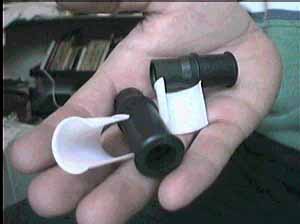| This procedure covers the
manly man Kelsey Hayes style floating caliper most used on VWs. We will
not be covering the girlie girling caliper. We will PUMP YOUR BRAKES UP!
First let's get the stuff together
that we'll need. 7MM allen key. Got one? How about those REALLY REALLY
REALLY big Channel Locks? No, not those. The REALLY BIG ONES. Also, some
German or "NAPA Lifetime" brake pads and some German guide pin bushings.
You will not find the bushings at Discount, Auto Zone, Rose, Checker's,
etc. more than likely. Even NAPA has them only in one store for every two
states. You'll need to go to a specialty VW store to get them. I got mine
at Total Performance Buggies here in Tampa. If you're lucky, you'll have
a choice between some cheap Brazilian bushing kits and the German ones
that I recommend. The difference is in the nylon sleeves that are inserted
into the rubber bushings. The Brazilian ones are cut out, square sheets
of plastic with no form or shape. They will need to be bent into a cylinder
shape and shoved into the rubber piece. If you're lucky, they'll stay when
you put the guide pins in. The German ones are already cylinder shaped
and have flared ends to keep them in place, even when the guide pins are
pushed in. If you can get the German ones PLEASE DO!
The first thing you are going to want to do is to remove the front wheels (duh). You might then want to remove the 15 MM bolts on the back of the hub. Don't. That's not necessary. That's just the brake pad carrier. You do, however, want to unscrew the two guide pins. Those are the 7 MM hex heads. When you unscrew these your caliper will separate from the carrier. Now you can remove the old brake pads and the rotor. Take a look at the boot on the caliper piston. If it is torn, you may want to reconsider this project. I have replaced this boot before and it's not VERY difficult, but you will have to separate the caliper from the brake line and get yourself a nice clean area to work. Also, if contamination has been allowed to enter the area between the piston and the caliper, due to this boot being ripped, the scoring caused by this can prevent smooth operation. Look into what a rebuilt caliper will cost. It might be worth it to buy a rebuilt caliper, which will have new bushings in it as well! Now, check out the holes that the guide pins came out of. You may see the remains of the caliper bushings here. If the bushings look as if they are in very good shape, leave them alone. Save the bushings you purchased for the next time. Any sign of the rubber degrading, ripping or cracking should warrant replacement. If your bushings are shot, cut out what's left of the old one and clean the area. Fold the new rubber bushing up so it easily fits into the guide pin hole of the caliper. You want the extended part of the rubber to point outward (away from the pads/rotor). I make a point of this because the first time I did this, I put them in backwards. This is not such a stupid mistake. Take a look at a Honda caliper, for instance. The extra rubber points inward, acting as a dust cover for the gap on the guide pin between the carrier and the caliper. On a VW they point outward to cover....Um....I dunno. But, they point out. Once the rubber insert is in place, you can put in the nylon sleeve. What I like to do is to wrap half of the guide pin up with the nylon and then start the nylon bushing in with the guide pin, turning the guide pin as I push. You may be lucky enough to simply push in the nylon and then push in the guide pin and not have the nylon push out of the opposite side, but this is no easy task. If there is any overlap in the nylon sleeve, the guide pin will not fit through the center of it and it will be pushed out. After you've conquered your
caliper, you'll need to push the piston back into the caliper so you can
fit the brake shoes in. You'll need the big Channel Locks for this. Just
put one jaw on the piston and the other jaw on the back of the caliper
and squeeze...HARD! After the piston is squeezed all of the way in, you
can slide on the inside brake shoe, the rotor and the outside brake shoe
(remember that the inside shoe is smaller than the outside shoe!). Place
the caliper over the whole mess and put the guide pins in and tighten them
down. Make sure the shoes are on the carrier properly or it will be a real
bear putting the caliper on.
|
